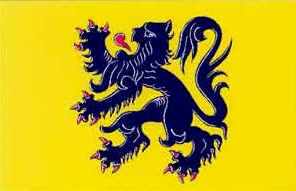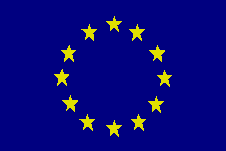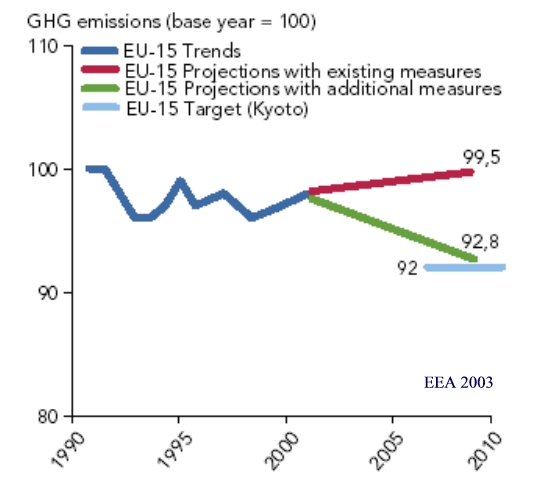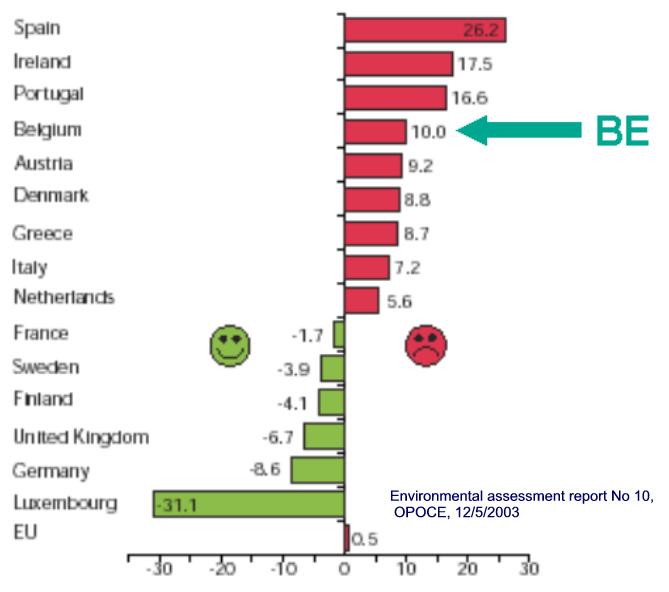- Flanders:
New rules for environmental audits and
conditions
|

|
The Belgian Official Journal of 9 March 2004 published
the Flemish Decree of 6 February 2004
adapting the Decree of 5 April 1995 on
the environmental policy regarding the
environmental audit and introducing
environmental conditions. Regarding
the environmental audit, the
modifications mainly aim at adapting the
wording to put it in line with the EMAS
regulation. More fundamental is the
introduction of three categories of
environmental conditions: general, sectoral
and integral:
- General: applicable to all
classified sites and activities or
as defined by the Flemish
government;
- Sectoral: applicable to non
classified sites and activities as
defined by the Flemish government;
- Integral: applicable to sites and
activities having, in normal
conditions, an homogenous or limited
impact on the environment.
General and sectoral conditions do
not apply when integral conditions ought
to be considered.
Click
here to read the full text of the
decree (Dutch and French only).
|
- Collecting
electrical batteries in Wallonia
|

|
The Belgian Official Journal of 4
March 2004 published the draft
environmental agreement on the mandatory
collection of electrical batteries in
the Walloon Region. The organisations
concerned are the Belgian
Federation of Electricity &
Electronics and BEBAT,
a Belgian non profit association
dedicated to the collection of
batteries. The agreement concerns the
free collection of batteries and would
be concluded for a period of 5 years. Comments
on the draft are invited and must be
supplied by 4 April 2004. Click
here to read the full text of the
draft (Dutch, French and German only).
|
- Trading
pollution allowances
|

|
On 4 march 2004, the European
Commission published a Q&R memo on
emission trading and national allocation
plans. Emission trading is seen as the
most economical way to reach the
objectives of the Kyoto protocol. It is
one of the means envisaged to reverse
the current trend in greenhouse gas
(GHG) emission (click
here to read our news on that
matter). To make trading possible it
is however necessary that the national
authorities define the emission
"allowances" of all major GHG
emitters in EU. Therefore, national
allocation plans (NAP's) should be
issued by 31 March 2004 (1 May 2004 for
the 10 acceding countries). From that
point, the companies concerned may
decide which route to follow to meet
their target: emission reduction or
buying supplementary allowances on the
market. Today, three NAP's have already
been published. Click
here to access the related EU
website. Click
here to read the full text of the EU
memo (English only).
|
- EPER:
Collecting European pollution data
|

|
On 23 February 2004, the European
Commission launched EPER, the European
Pollutant Emission Register.
EPER is publicly accessible and
gathers detailed information on
pollution from about 10,000 large and
medium-sized industrial facilities in EU
and Norway. It covers 50 different
pollutants. The basis for EPER is the
Directive 96/61/EC on integrated
pollution prevention and control (IPPC)
which requires that an inventory of
principal emissions and sources of
pollution be published every three
years. Read the full text of the EU
communiqué in: English,
français Click
here to access the EPER website.
|
- Monitoring
and reporting greenhouse gas emissions
|

|
The Official Journal of the European
Union (OJ) of 19 February 2004 publishes the
Decision No 280/2004/EC of the European
Parliament and of the Council of 11
February 2004 concerning a mechanism for
monitoring Community greenhouse gas
emissions and for implementing the Kyoto
Protocol. That decision replaces
the decision 93/389/EEC having the same
object. It provides the necessary
instruments to follow up the realisation
of the EU objectives within the
framework of the Kyoto protocol. Read the
full text of the decision in: English,
français,
Nederlands In
that framework, reduction of greenhouse
gas (GHG) emissions is not the only
solution. Indeed, the Directive
2003/87/EC establishes a scheme for GHG
allowance trading. To put the latter in
practice, it is however unavoidable to
have common rules to monitor and
calculate the GHG emissions and
captures/storages. This was done by the
publication in the OJ of 26 February
2004 of the Commission Decision of 29
January 2004 establishing guidelines for
the monitoring and reporting of
greenhouse gas emissions pursuant to
Directive 2003/87/EC of the European
Parliament and of the Council
(2004/156/EC). Read the full text
of the decision in: English,
français,
Nederlands
(334 kByte)
|
- Adapting
VLAREM and VLAREBO
|

|
The Belgian official journal of 13 February 2004 publishes two
decrees modifying the Flemish environmental regulation (VLAREM I &
II and VLAREBO): Decree of 28 November 2003 and decree of 12 December
2003.
The first decree concerns mainly the storage of wastes and the
prescriptions for the storage tanks. The modifications concern among
others the frequency of the inspections. The latter can generally be
less frequent but for some dioxin measurements that could be increased
up to three times a year.
Click
here to read the full text of the decree (Dutch and French only).
The second decree transposes in Flanders the European Directive
2000/76/EC on the incineration of waste.
Click
here to read the full text of the decree (Dutch and French only).
|
- The
inventory of air pollution is out
|

|
The 3d edition of the EMEP/CORINAIR Emission Inventory Guidebook,
October 2003 update, is now available from the EEA website.
That report was prepared by the UNECE/EMEP Task Force on Emissions
Inventories and Projections. It is designed to provide a comprehensive
guide to state-of-the-art of atmospheric emissions inventory methodology
to support reporting under the UNECE Long-Range Transboundary Air
Pollution convention and the National Emission Ceiling Directive of the
EU.
EMEP programme: Co-operative
Programme for Monitoring and Evaluation of the Long-Range Transmission
of Air pollutants in Europe
UNECE: United Nations Economic
Commission for Europe
Click
here to access the report (English only).
|
- European
forests are now in focus
|

|
The Official Journal of the European Union of 11 December 2003
published the Regulation (EC) No 2152/2003 of the European Parliament
and of the Council of 17 November 2003 concerning monitoring of forests
and environmental interactions in the Community (Forest Focus).
This regulation, which is immediately applicable throughout the
Union, establishes a Community scheme for broad-based, harmonised and
comprehensive, long-term monitoring of the condition of forests. The
scheme includes the impact of pollution on forest as well as monitoring
and prevention of forest fires. It also covers the assessment of the
requirements for and the monitoring of soils, carbon sequestration,
climate change effects and biodiversity, as well as protective functions
of forests.
The regulation comes with a budget of EUR 61 millions for the period
2003 to 2006. EUR 9 millions shall be devoted to fire prevention
measures.
Read the full text of the regulation in: English,
français,
nederlands
|
- Europe
is not likely to reach its Kyoto
target
|

|
| A recent report of the European
Environment Agency - EEA - shows that the European Union has
difficulties to reach its target of reducing its emission of
greenhouse gas by 8% by 2010.
Till 2000, the trend was rather coherent with the target.
However, the 2001 data show a significant deviation from the
expected trend. An extrapolation of that trend considering the
current policies shows that the reduction would only be of 0.5%.
Most sectors are on target. However, emissions from transport
increased by 21% since 1990. |
 |
Member States consider additional policies (trading schemes,
electricity from renewable energy, energy performance of buildings...)
to help meeting their targets. An optimistic view is that the reduction
could then be of 7.2%, if emission cuttings are larger than expected in
some major countries. This is unlikely to happen while a reduction of
5.1% seems more achievable.
Click here to read the
summary report of the EEA (English only).
|
- Getting
an official interpretation of ISO
9001:2000
|

|
Since 1 December 2003, the official interpretations of the ISO
9001:2000 clauses issued by ISO/TC 176 are publicly available from the
ISO/TC 176 website.
The related web page also includes an "Interpretation Request
Form" which would allow you to trigger the interpretation process.
However, your request should be channelled through the "Member
Bodies". Only requests for interpretation are accepted, not
questions on how to comply with a given clause.
Click here to access
the ISO/TC 176 interpretation page.
|
|
|

|
On 15 December 2003, the transition period for the migration
of accredited certificates from the 1994 editions of ISO9001, ISO 9002
and ISO 9003 expire.
After that date, the only valid accredited certificates are those
stating conformity with the requirements of ISO 9001:2000.
The principles behind the 1994 editions appeared in 1970 in the BS
5750 series. The first editions of the ISO 9000 series appeared in 1987.
In 1990, a revision in two phases was decided by ISO - TC 176. The 1994
editions were the first phase. The present editions were published at
the end of 2000, moment at which the transition period started.
|
- Ozone
peaks in Europe in summer 2003
|

|
| The European Environment Agency - EEA -
has just released its report on the ozone levels recorded through
Europe during summer 2003.
According to Council Directive 92/72/EEC, the EU Member States
have to inform the public when hourly average ozone concentrations
exceed the information threshold of 180 µg/m³. Since 9 September
2003, that Directive is replaced by Directive 2002/3/EC. The
latter has the same information threshold but also an alert
threshold of 240 µg/m³ measured as an hourly average over a
period of three consecutive hours.
All EU Member States provided information on time together with
16 other countries including the coming members.
The attached map shows the repartition of ozone peaks gathered
by 1805 monitoring sites during the last summer period. |
 |
The first conclusion is that we have experienced a relatively large
number of peaks, mainly in the first part of August, as a result of the
very high temperature exceeding season's averages. The most annoying
fact is that the records show no sign of a downward trend in ozone
concentration. Further reduction in precursor emissions would then be
necessary in the future to achieve the target values set in the new
Directive.
Click here to read the
summary report (English only)
|
- The
Climate Plan of Belgium
|

|
The Belgian official journal of 15 July 2003 published the law of 11
April 2003 on the agreement between the federal government and the
regional authorities on the establishment and execution of a national
climate plan.
|
That plan is necessary to allow Belgium to fulfil
its obligations in the framework of the Kyoto protocol on the
reduction of the emission of greenhouse gases. For Belgium, the
target is a reduction of 7.5% with regards to the emissions in
1990.
If the situation is relatively under control at
the European level, much work is needed in that area in Belgium.
Indeed, the statistics show that the emissions have increased by
10% in the last 10 years. |

|
Click
here to read the law and the underlying agreement (Dutch and French
only).
|
- Public
involvement in environmental
programmes and access to justice
|

|
On 25 June 2003, the Official Journal of the European Union published
the Directive 2003/35/EC of the European Parliament and of the
Council of 26 May 2003 providing for public participation in respect of
drawing up certain plans and programmes relating to the environment and
amending with regard to public participation and access to justice
Council Directive 85/337/EEC and 96/61/EC. This Directive
completes the Directive 2003/4/EC published on 14 February 2003 with
regard to the implementation of the Århus Convention. Besides
specifying the participation of public to plans and programmes, the
Directive requires that members of the public having a sufficient
interest or maintaining the impairment of a right have access to a
review procedure before a court of law. The Member States have to
determined what this means. However, recognised non-governmental
organisations will be deemed to have sufficient interest or right.
Click here to read our note
on the Directive 2003/4/EC.
Read the full text of Directive 2003/35/EC in: English,
français,
nederlands
|
© 2000, CEBEC s.c.r.l.. All material on this
web-site may be reproduced and used provided explicit reference is made to
CEBEC as the information source.
If in doubt, please contact CEBEC.
|


